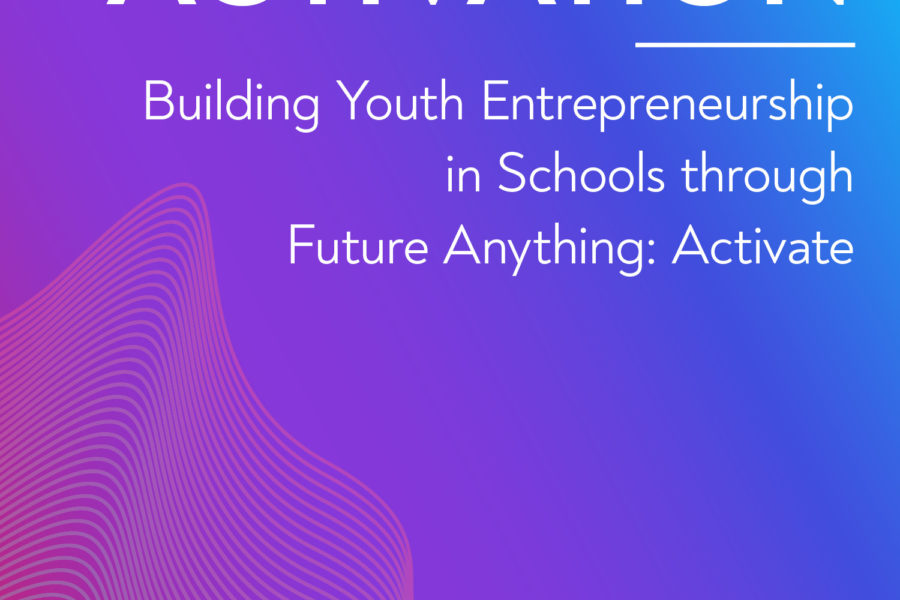Activation Podcast – Episode No. 3
Fiona Pennisi Mitchell is a teacher at Marsden State High School in Queensland. She’s been involved in delivering Future Anything’s Activate program in her classrooms for several years. Here, she talks to Future Anything’s Nicole Dyson to unpack the changes, challenges and choices she has made to contextualise Activate for Marsden SHS’s young people.
Activation Podcast with Fiona Pennisi Mitchell, Marsden SHS – Full Transcript
Nicole Dyson: Have you ever wondered what Activate looks, feels and sounds like in the classroom? Are you curious about the successes and potential sinkholes for teachers and students? Welcome to Activation: Future Anything Activate in Action. Here we sit down with our Activate Alumni, educators just like you, who have delivered the Future Anything Activate program in previous years. We unpack the changes, challenges and choices they have made to contextualise the program for their young people. Grab a cup of your favourite liquid and settle in as we dive into Activate in Action.
Nicole: Okay, good afternoon everybody! I am here with my next legendary, I guess we could call it guest, in this pseudo podcast where we chat to Activate teachers and, I guess, just talk through experiences and reflections and advice and stories about how the Activate program worked in your school and for you. Super stoked to talk to Fiona from Marsden State High. Fiona, how are you this fine Friday?
Fiona Pennisi Mitchell : I am great, thank you Nicole.
Nicole: Wonderful. Hanging for holidays, yes?
Fiona: Absolutely. Almost there!
Nicole: It’s been a chaotic term for educators. I think that the back end of the term is exhausting enough without adding all the additional complexities that educators are juggling at the moment.
Fiona: I agree. But at the same time, I think it is exciting because we get to, we’re forced into the 21st century and we are becoming so tech savvy. I’m really proud of teachers and how we have actually risen to this challenge and myself as well. I’ve always been quite terrified of technology, you know, having to use these different platforms, it’s actually very exciting in terms of opportunities and possibilities.
Nicole: Yeah, I had a conversation with somebody recently around, in some ways, and terribleness aside, and acknowledging the risks for particular members of our communities is so very real is tragic in America and Spain and Italy. But, in 12 months-time, I’m curious to see what the hangover is in the sense of what changes we’ll have created or accelerated within, not only education but also society. The sense that, there’s a vast number of people that are currently working from home, like, I wonder if the way that we do work after this will be the same and similarly with education, which I think is kind of exciting.
Fiona: I absolutely agree with that, Nicole, and I think that that leads in really well with the topic of today’s discussion because all of those implications will flow onto what Future Anything is all about.
Nicole: Well, perfect segue. I didn’t even need to do it. You’re a, I don’t even know who the host is anymore, might be you. Tell us a little bit about you and, I guess, when you delivered the program and what you delivered the program in and just give us a bit of context around your engagement in Activate.
Fiona: Sure. So, my name’s Fiona. I’m an English and Music high school teacher, I’ve been teaching for the last 15 years at a very large and complex state high school. I was really really lucky to have the opportunity presented to me. I enjoy being really creative in my teaching, I think that’s English teachers in general, you know, but being in the Arts, I like to do things differently. I like to try and make the lessons relevant and engaging, not just for the students but for me. So, I found that I was becoming a little bit disillusioned with education and I actually started questioning whether I was in the right field, if what I was doing was even worthwhile. I was, it’s always coincidental in life, how things happen, and I was sort of in this process of questioning everything and I was approached by a colleague, who had run the program previously at our school with students. Because I had two Year Nine English classes last year, I was given that opportunity. I jumped. You know, I’d sort of seen what was happening the year before and just going into that program and having those experiences really gave me that amazing sense of okay, you know, thank you universe, you’ve answered my question, I’m no longer searching for the answer, this is it, this is what I’ve been looking for and yeah, that’s how it happened.
Nicole: Yeah, cool. I’d love to dig into, maybe, some of the changes that you saw across, I guess the course of being in the program and changes with, it might be particular students, changes with teaching or staffing in general at the school or maybe your school community. But what are some of the things that you’ve seen different as a result of the school engaging in the Future Anything Program?
Fiona: I have noticed, obviously, a lot of changes and because the program has been growing at our school, it’s become this amazingly big, creative change within our school and in our community. We had, especially because the unit we did before this program with the students was completely the opposite and I found students that were completely disengaged, didn’t see the importance, those constantly questioning kids; “why are we doing this? when am I going to use this in my real life? What is the point?” those kids suddenly became, you know, the amazing kids that were always putting their hands up and thinking outside the box. That, what sometimes, can turn to distracting behaviour in the classroom because they just don’t care, was being harnessed in a positive direction and it was just so great as a teacher to see those kids using the power for good. I think, also beyond the obvious change that you expect to see in the students, there was a change in the school. I’m just going to wait for the bell is that okay?
Nicole: yeah, of course.
Fiona: I don’t know if you can hear that.
Nicole: Yeah, I can. What’s the tune for today? That’s what I’m curious about.
Fiona: I’m not sure. Oh, there won’t be a tune because this is the start of lunch so there’ll be a tune at about 1pm.
Nicole: Alright, cool.
Fiona: Sorry! Beyond the changes with students, their engagement, obviously, that flow on effect to their achievement results. We had a schoolwide shift. The Year Nine cohort would be demonstrating to the Year Eights, this is what’s possible and the Year Eights would start to look forward to that. Within the teaching staff, there was a lot more positivity, there was a lot more creativity. We were, because we were team teaching this subject, we got to bounce ideas off each other and just share that collective wealth of experience and networking and knowledge and all of these changes were really really positive for our school.
Nicole: Yeah, thank you. I’d love to, I mean there’s lots of different changes from a few different spheres that you’ve, kind of, highlighted there. From your point of view, what do you think is the most significant change? And maybe tell us what it looked like before and how it, sort of, went from what it was to what it is.
Fiona Pennisi Mitchell: I, to be honest, for me personally, the most significant of these changes, in my opinion, is actually the teacher’s point of view. And I know, I feel like we’re expected to go “it’s the students, because they’ve achieved better and their more engaged with education”, and this is absolutely important and I’m not disregarding that in any way. But, if I had to pick what I think, personally, is the most significant, I actually think it’s the teacher’s point of view. As I mentioned, I was becoming disillusioned. I was questioning whether I should even be in education, and what I should be doing, where education was heading. I think, for us as educators, having this reminder that it doesn’t have to be that way. So, being in this program hasn’t just impacted upon us as teachers for that time that we’re delivering it, but it’s continued. I’m applying ideas and concepts from that program into every lesson that I teach. The way that I think about education and teaching is completely changed from where it was before. Previously, I guess I was really trying my hardest to do what I thought was expected of me and sometimes, I think, as people when we are, when we’re doing something we don’t truly believe in, that absolutely translates into the class. So, for example, if you’re teaching a class and you can’t see why you’re doing it, you don’t find it worthwhile yourself, your students will pick up on that and I think, the fact that the Future Anything Program is a real-world authentic educational program that once educators are invested in that process, then that is our basis for success because once your teachers are completely onboard with what they’re doing, that just inherently flows onto the students. So, I guess, from my point of view, I think just having that change in teacher mindset is probably the most powerful and significant change that I have observed.
Nicole: Yeah, that’s so powerful and I think what’s really interesting, hearing you speak, is that, I mean, you were 15 years deep in your career when this occurred, so very experienced educator in the classroom tapping into a bit of a different way of teaching and learning. How, what advice or, I guess, how does an educator or a school, what are some things that you can do to help build that or change that teacher mindset that you just referred to then? What are things that helped you, or supported you and your teaching team to make that transition from what was to what is now?
Fiona Pennisi Mitchell: I think, probably my main points of advice would be, making sure that teachers, the school community, school leaders are supportive and are flexible. I mean, I would say most educators nowadays, especially in this current climate, are absolutely embracing the changes. But I think, if you have a leadership team, you have staff who are open to different ways of doing things, who are excited by change and not necessarily terrified by it. I think, you will get the most out of this program. So, I would, basically to sum that up, my main advice is just to be really open and be real and try to remember what your ultimate goal is. So, is it to tick off some outcomes, or is it to actually provide an opportunity for students to undertake real and authentic learning and I think when you boil it down to the ultimate goal of why we’re here, then you will realise that this program inherently ticks off any standards that you need because it is authentic, it’s real, the students are learning in a dynamic context. These are all skills that we’re trying to compare students to use in a future that we can’t even imagine. We don’t know what it will be like. So, I think, that’s the beauty of this program that all of those learning outcomes are imbedded into the course through the Entrepreneurs Odyssey or what you could think of as the students overall learning journey. I think if you just embrace those changes and don’t get caught up in whether or not you’re achieving specific outcomes, you will find it an amazingly positive and worthwhile experience.
Nicole: Yeah, that’s so cool. What do you think is the hardest point in the program for young people? So, if you think about that Entrepreneur’s Odyssey that students move through, where do you think students hit the biggest roadblock in that journey?
Fiona Pennisi Mitchell: I found the majority of our students really struggled to define their ultimate problem that they wanted to address and, you know, many many times we would say “yes, homelessness is a problem but you can’t fix all of homelessness, let’s be specific”. And we did all the activities, but a lot of students still struggled with that. I mean, they are young people and we’re not expecting them to solve all the problems of the world, but, I mean, if I think back to the main issue, I would say that that would be it. Once, they figured out their specific area that they were working on, not the entire problem, it was smooth sailing. But often we would have to come back to that point because they would go a little bit further and then realise no I can’t solve world hunger I need to go back and figure this out a bit further.
Nicole: So, in those moments where they kind of had to, I mean, the example that we often use is that homelessness is a great one because it’s often quite a popular choice for young people to tap into. I would hazard, this year, the popular choices things around pandemics and bushfires because obviously it’s quite fresh in people’s minds. But if we take the homelessness example, I mean, Orange Sky Australia are a great example of not tackling homelessness as a broad issue but just tackling that unique problem of getting clean clothes and a conversation for people that are sleeping rough so really drilling down into a smaller, specific component of the problem that’s solvable. What are some of the activities or questions or redirections that helped students to get more specific about the problem that they want to tackle?
Fiona Pennisi Mitchell: Yeah, absolutely. So, we found that taking them back to the Root Cause Tree. Perhaps even, depending on the issue that they’re looking at, going and finding some real, authentic examples of whatever that was, just got them thinking outside the norm, you know, the stereotypical ideas and just got them on a different train of thought because often it’s the ideas that are so surprisingly simple that are the most worthwhile that are often overlooked because people are so caught up on that bigger picture. So, I would say, definitely we went back to the Root Cause Tree over and over again. Some groups did that so many times, they could’ve created a forest with all their trees. But it was just so worthwhile when they finally made that link, they made that step and they got to whatever their area was that was something that they could actually make some sort of difference to. It was just great. It was really lovely to be a part of and to see that happening.
Nicole: Yeah! Tell us about some of the ideas that kids came up with last year. So, I totally hear you on the sometimes the simplest ideas are the most powerful. But what are some of the cool ideas that your young people came up with last year that you were excited by?
Fiona Pennisi Mitchell: One that instantly springs to mind, that is not necessarily the best one but just popped into my head was we had students thinking, you know, really really locally within our own school and thinking about creating a, like, a mental health support system for students, my students. They argued that a lot of times as a teenager you might not want to talk to a 40-year-old person who’s not experiencing the same things as you. They had this great idea about having student volunteers within the school and creating this program where they were available to support, to listen to other students who are going through things and just being that very authentic, current, real person that was available and of course there were different elements within that that needed to be addressed about whether those students were trained, all of the issues that you’d normally have in any program of that nature. But that just springs to mind as something that no one else had really thought of and we didn’t really know why because it was a really worthwhile idea that would just give such amazing rewards to our school.
Nicole: Yeah, cool. I love that. I think, what I’m really struck by in that idea is that the students obviously took a context that was familiar to them and then something that they cared about. So, there was that real connection between their own personal lived experiences and then obviously a problem that they were passionate about solving. Are there any other secret ingredients to a good idea for young people? Like, what’s the difference between an idea that doesn’t really have legs and then one that is compelling or profound?
Fiona Pennisi Mitchell: Well, I think the answer to that question is addressed right away in the Future Anything Program and that’s being invested, being connected to your issue. If you’re choosing something that you’ve had no lived experience of or, you know, you don’t, you’ve never seen it. So, if we go back to the homelessness, obviously if you have no personal connection to this, it’s not going to be as powerful. As you mentioned, this mentoring support program where students in the program actually, possibly, are going through a lot of the same things. So, I think, yeah, it’s most important to be really, truly, authentically connected to whatever it is you’re working on and not just doing it for the sake of doing it.
Nicole: Cool. Fiona, thank you so much for your time and for sharing some of your experiences running Activate in your classroom. Particularly on the last day of term one while there’s a lot of craziness about. Is there anything else that you feel like is important that teachers know or any sort of last messages that you want to, I guess, impart to the 46 schools, I think, that are delivering activate around the country this year?
Fiona Pennisi Mitchell: I think, probably just to reiterate the point that if you are lucky enough to be a part of this program at the moment, I recommend that you make yourself just really open, be open minded to all the opportunities that become available for you, for your school, in your class context. Obviously, like we’ve said a few times, in today’s uncertain times, entrepreneurialism, which is being able to take opportunities and run with them, is probably one of the most important skills we can actually foster in these young people in order to prepare them for success in their future lives.
Nicole: So true. Well, again, thank you for your time. Have the best, most well deserved break, over the holidays, and really appreciate you sharing your insights with us and our teachers that are delivering the program this year.
Fiona Pennisi Mitchell: Thank you so much, Nicole.
Nicole: Thanks for listening to Activation. Do you want to know more about Future Anything Activate? Head to our website www.futureanything.com. Or you can find us across all of the socials. We look forward to working with you to form the future, one youth-led idea at a time.



